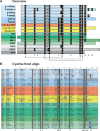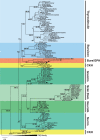Glycoprotein hormones and their receptors emerged at the origin of metazoans
- PMID: 24904013
- PMCID: PMC4079206
- DOI: 10.1093/gbe/evu118
Glycoprotein hormones and their receptors emerged at the origin of metazoans
Abstract
The cystine knot growth factor (CKGF) superfamily includes important secreted developmental regulators, including the families of transforming growth factor beta, nerve growth factor, platelet-derived growth factor, and the glycoprotein hormones (GPHs). The evolutionary origin of the GPHs and the related invertebrate bursicon hormone, and their characteristic receptors, contributes to an understanding of the endocrine system in metazoans. Using a sensitive search method with hidden Markov models, we identified homologs of the hormones and receptors, along with the closely related bone morphogenetic protein (BMP) antagonists in basal metazoans. In sponges and a comb jelly, cystine knot hormones (CKHs) with mixed features of GPHs, bursicon, and BMP antagonists were identified using primary sequence and phylogenetic analysis. Also, we identified potential receptors for these CKHs, leucine-rich repeat-containing G protein-coupled receptors (LGRs), in the same species. Cnidarians, such as the sea anemone, coral, and hydra, diverged later in metazoan evolution and appear to have duplicated and differentiated CKH-like peptides resulting in bursicon/GPH-like peptides and several BMP antagonists: Gremlin (Grem), sclerostin domain containing (SOSD), neuroblastoma suppressor of tumorigenicity 1 (NBL1), and Norrie disease protein. An expanded cnidarian LGR group also evolved, including receptors for GPH and bursicon. With the appearance of bilaterians, a separate GPH (thyrostimulin) along with bursicon and BMP antagonists were present. Synteny indicates that the GPHs, Grem, and SOSD have been maintained in a common gene neighborhood throughout much of metazoan evolution. The stable and highly conserved CKGFs are not identified in nonmetazoan organisms but are established with their receptors in the basal metazoans, becoming critical to growth, development, and regulation in all animals.
Keywords: BMP antagonist; GPH evolution; LGR evolution; bursicon; cystine knot growth factor; thyrostimulin.
© The Author(s) 2014. Published by Oxford University Press on behalf of the Society for Molecular Biology and Evolution.
Figures







Similar articles
-
Crystal structure of LGR ligand α2/β5 from Caenorhabditis elegans with implications for the evolution of glycoprotein hormones.Proc Natl Acad Sci U S A. 2023 Jan 3;120(1):e2218630120. doi: 10.1073/pnas.2218630120. Epub 2022 Dec 27. Proc Natl Acad Sci U S A. 2023. PMID: 36574673 Free PMC article.
-
Comparative genomics of leucine-rich repeats containing G protein-coupled receptors and their ligands.Gen Comp Endocrinol. 2008 Jan 1;155(1):14-21. doi: 10.1016/j.ygcen.2007.06.022. Epub 2007 Jul 4. Gen Comp Endocrinol. 2008. PMID: 17706217 Review.
-
Structural and evolutionary insights into the functioning of glycoprotein hormones and their receptors.Andrology. 2025 Jan 27. doi: 10.1111/andr.70001. Online ahead of print. Andrology. 2025. PMID: 39871527 Review.
-
Conservation of the heterodimeric glycoprotein hormone subunit family proteins and the LGR signaling system from nematodes to humans.Endocrine. 2005 Apr;26(3):267-76. doi: 10.1385/ENDO:26:3:267. Endocrine. 2005. PMID: 16034181
-
Evolutionary conservation of bursicon in the animal kingdom.Gen Comp Endocrinol. 2007 Aug-Sep;153(1-3):59-63. doi: 10.1016/j.ygcen.2006.12.004. Epub 2006 Dec 27. Gen Comp Endocrinol. 2007. PMID: 17275819
Cited by
-
Starfish Gonadotropic Hormone: From Gamete-Shedding Substance to Relaxin-Like Gonad-Stimulating Peptide.Front Endocrinol (Lausanne). 2019 Mar 25;10:182. doi: 10.3389/fendo.2019.00182. eCollection 2019. Front Endocrinol (Lausanne). 2019. PMID: 30967842 Free PMC article. Review.
-
AlphaFold-guided molecular replacement for solving challenging crystal structures.Acta Crystallogr D Struct Biol. 2025 Jan 1;81(Pt 1):4-21. doi: 10.1107/S2059798324011999. Epub 2025 Jan 1. Acta Crystallogr D Struct Biol. 2025. PMID: 39711199
-
In Silico Prediction of Neuropeptides/Peptide Hormone Transcripts in the Cheilostome Bryozoan Bugula neritina.PLoS One. 2016 Aug 18;11(8):e0160271. doi: 10.1371/journal.pone.0160271. eCollection 2016. PLoS One. 2016. PMID: 27537380 Free PMC article.
-
Structural Biology and Evolution of the TGF-β Family.Cold Spring Harb Perspect Biol. 2016 Dec 1;8(12):a022103. doi: 10.1101/cshperspect.a022103. Cold Spring Harb Perspect Biol. 2016. PMID: 27638177 Free PMC article. Review.
-
Evolution of neuropeptide signalling systems.J Exp Biol. 2018 Feb 9;221(Pt 3):jeb151092. doi: 10.1242/jeb.151092. J Exp Biol. 2018. PMID: 29440283 Free PMC article. Review.
References
-
- Abascal F, Zardoya R, Posada D. ProtTest: selection of best-fit models of protein evolution. Bioinformatics. 2005;21:2104–2105. - PubMed
-
- Avsian-Kretchmer O, Hsueh AJW. Comparative genomic analysis of the eight-membered ring cystine knot-containing bone morphogenetic protein antagonists. Mol Endocrinol. 2004;18:1–12. - PubMed
Publication types
MeSH terms
Substances
LinkOut - more resources
Full Text Sources
Other Literature Sources
Miscellaneous

